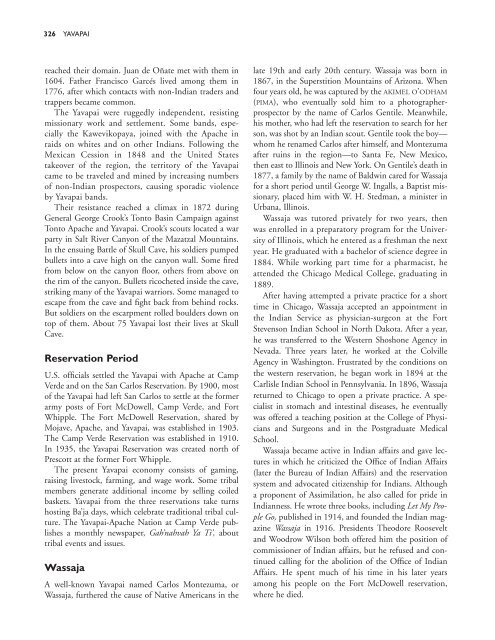Create successful ePaper yourself
Turn your PDF publications into a flip-book with our unique Google optimized e-Paper software.
326 YAVAPAI<br />
reached their domain. Juan de Oñate met with them in<br />
1604. Father Francisco Garcés lived among them in<br />
1776, after which contacts with non-Indian traders and<br />
trappers became common.<br />
The Yavapai were ruggedly independent, resisting<br />
missionary work and settlement. Some bands, especially<br />
the Kawevikopaya, joined with the Apache in<br />
raids on whites and on other Indians. Following the<br />
Mexican Cession in 1848 and the United States<br />
takeover <strong>of</strong> the region, the territory <strong>of</strong> the Yavapai<br />
came to be traveled and mined by increasing numbers<br />
<strong>of</strong> non-Indian prospectors, causing sporadic violence<br />
by Yavapai bands.<br />
Their resistance reached a climax in 1872 during<br />
General George Crook’s Tonto Basin Campaign against<br />
Tonto Apache and Yavapai. Crook’s scouts located a war<br />
party in Salt River Canyon <strong>of</strong> the Mazatzal Mountains.<br />
In the ensuing Battle <strong>of</strong> Skull Cave, his soldiers pumped<br />
bullets into a cave high on the canyon wall. Some fired<br />
from below on the canyon floor, others from above on<br />
the rim <strong>of</strong> the canyon. Bullets ricocheted inside the cave,<br />
striking many <strong>of</strong> the Yavapai warriors. Some managed to<br />
escape from the cave and fight back from behind rocks.<br />
But soldiers on the escarpment rolled boulders down on<br />
top <strong>of</strong> them. About 75 Yavapai lost their lives at Skull<br />
Cave.<br />
Reservation Period<br />
U.S. <strong>of</strong>ficials settled the Yavapai with Apache at Camp<br />
Verde and on the San Carlos Reservation. By 1900, most<br />
<strong>of</strong> the Yavapai had left San Carlos to settle at the former<br />
army posts <strong>of</strong> Fort McDowell, Camp Verde, and Fort<br />
Whipple. The Fort McDowell Reservation, shared by<br />
Mojave, Apache, and Yavapai, was established in 1903.<br />
The Camp Verde Reservation was established in 1910.<br />
In 1935, the Yavapai Reservation was created north <strong>of</strong><br />
Prescott at the former Fort Whipple.<br />
The present Yavapai economy consists <strong>of</strong> gaming,<br />
raising livestock, farming, and wage work. Some tribal<br />
members generate additional income by selling coiled<br />
baskets. Yavapai from the three reservations take turns<br />
hosting Ba’ja days, which celebrate traditional tribal culture.<br />
The Yavapai-Apache Nation at Camp Verde publishes<br />
a monthly newspaper, Gah’nahvah Ya Ti’, about<br />
tribal events and issues.<br />
Wassaja<br />
A well-known Yavapai named Carlos Montezuma, or<br />
Wassaja, furthered the cause <strong>of</strong> <strong>Native</strong> <strong>American</strong>s in the<br />
late 19th and early 20th century. Wassaja was born in<br />
1867, in the Superstition Mountains <strong>of</strong> Arizona. When<br />
four years old, he was captured by the AKIMEL O’ODHAM<br />
(PIMA), who eventually sold him to a photographerprospector<br />
by the name <strong>of</strong> Carlos Gentile. Meanwhile,<br />
his mother, who had left the reservation to search for her<br />
son, was shot by an Indian scout. Gentile took the boy—<br />
whom he renamed Carlos after himself, and Montezuma<br />
after ruins in the region—to Santa Fe, New Mexico,<br />
then east to Illinois and New York. On Gentile’s death in<br />
1877, a family by the name <strong>of</strong> Baldwin cared for Wassaja<br />
for a short period until George W. Ingalls, a Baptist missionary,<br />
placed him with W. H. Stedman, a minister in<br />
Urbana, Illinois.<br />
Wassaja was tutored privately for two years, then<br />
was enrolled in a preparatory program for the University<br />
<strong>of</strong> Illinois, which he entered as a freshman the next<br />
year. He graduated with a bachelor <strong>of</strong> science degree in<br />
1884. While working part time for a pharmacist, he<br />
attended the Chicago Medical College, graduating in<br />
1889.<br />
After having attempted a private practice for a short<br />
time in Chicago, Wassaja accepted an appointment in<br />
the Indian Service as physician-surgeon at the Fort<br />
Stevenson Indian School in North Dakota. After a year,<br />
he was transferred to the Western Shoshone Agency in<br />
Nevada. Three years later, he worked at the Colville<br />
Agency in Washington. Frustrated by the conditions on<br />
the western reservation, he began work in 1894 at the<br />
Carlisle Indian School in Pennsylvania. In 1896, Wassaja<br />
returned to Chicago to open a private practice. A specialist<br />
in stomach and intestinal diseases, he eventually<br />
was <strong>of</strong>fered a teaching position at the College <strong>of</strong> Physicians<br />
and Surgeons and in the Postgraduate Medical<br />
School.<br />
Wassaja became active in Indian affairs and gave lectures<br />
in which he criticized the Office <strong>of</strong> Indian Affairs<br />
(later the Bureau <strong>of</strong> Indian Affairs) and the reservation<br />
system and advocated citizenship for Indians. Although<br />
a proponent <strong>of</strong> Assimilation, he also called for pride in<br />
Indianness. He wrote three books, including Let My People<br />
Go, published in 1914, and founded the Indian magazine<br />
Wassaja in 1916. Presidents Theodore Roosevelt<br />
and Woodrow Wilson both <strong>of</strong>fered him the position <strong>of</strong><br />
commissioner <strong>of</strong> Indian affairs, but he refused and continued<br />
calling for the abolition <strong>of</strong> the Office <strong>of</strong> Indian<br />
Affairs. He spent much <strong>of</strong> his time in his later years<br />
among his people on the Fort McDowell reservation,<br />
where he died.


















